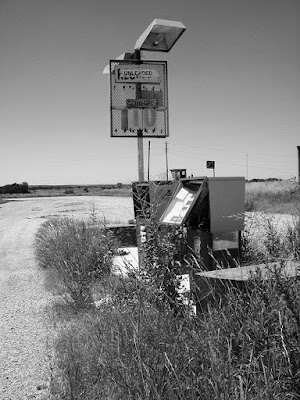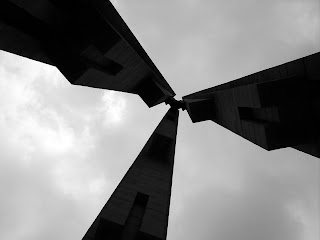The HOME Project has been fifteen years in the making and is a retrospective of my very personal work. These images are from the two portfolios "The Reservation" and "The Valley", while originally shot in color they are printed in black and white to once again remind viewers of the tradition of documentary photography which used to be considered as more truthful than color photography. It also was perceived as artsy and also as historical instead of present day. All three of these ideas were ideas I wanted to express about the lives of American Indians today. Most of all I wanted to show that home to me is a very deep and multi-faceted idea of importance to an individual. Limited edition prints (20 - 13" x 19" and 5 - 24" wide roll paper, with 1 - 13" x 19" reserved for the exhibition) and the full low res and reduced size catalog are available on request if you wish to purchase (purchases come with provenances).
Tuesday, July 7, 2015
Sunday, June 23, 2013
Revisiting the American West
During graduate school I had the luck to go on a field
trip to Fort Worth’s Amon Carter Museum of Art and see original prints
from In The American West. In 1979. Richard Avedon was commissioned by
the museum to produce an encyclopedic series of portraits. Avedon was the preeminent
American photographer, a New Yorker, successful in commercial photography and
portraits, was hired to collect images of a region filled with myths. Such projects were not new to photography,
but the images he created were innovative.
Focusing on the rural West, Avedon visited ranches and
rodeos, but he also went to truck stops, oil fields, and slaughterhouses.
Rather than playing to the western myths of grandeur and space, he sought out
people whose appearance and life circumstances were the antithesis of mythical
images of the ruggedly handsome cowboy, dashing outdoor adventurer, or
beautiful pioneer wife. The subjects he chose for the portraits were ordinary
people, coping daily with personal cycles of boom and bust.
from
the Stanford University Cantor Arts Center press release on the 20th
anniversary tour of the exhibit
The United States Geological Survey was created to
document the lands the nation wanted to occupy and settle to illustrate its resources. Photographers such as Timothy O’Sulliavn and
Carleton Watkins documented the ‘unspoiled’ riches of the West for the survey. Eadweard Muyerbridge, an Englishman who came
to the American West for the Gold Rush in 1855, after a stagecoach accident
became a photographer and documented Yosemite Valley, San Francisco, the
Tlingit people of Alaska, and the Modoc War of 1873. John Pierpoint Morgan, the financier,
commissioned Edward Curtis, in 1906, to produce the twenty volume collection, The North American Indian, to capture the ‘vanishing race’, a phrase Curtis
used and manipulated.
Ed Ruscha, an Oklahoman, undertook Twenty Six Gasoline
Stations in 1962 to report on his trips back and forth between Los Angeles
where he was studying art and his home in Oklahoma City.
I had a vision that I was a great reporter when I did the
gasoline stations. I drove back to
Oklahoma all the time, five or six times a year. And I felt there so much wasteland between
L.A. and Oklahoma City that somebody had to bring in the news to the city. It was just a simple, straightforward way of
getting the news and bringing it back. I
think it’s one of the best ways of just laying down the facts of what is out
there. …
It’s nothing more than a training manual for people who want to know
about things like that.
Edward Ruscha in Edward Ruscha
Photographer
There
has been this great yearning of Americans to try to understand what is out
there in the vast, wide open, relatively unexplored West. Americans no longer expected the West to be
Indians surrounding a stagecoach.
Instead, at that time, the West was station wagons at gas stations
trying to get to national parks or moving out to California for opportunity. Americans still have a love of nature and try
to preserve ‘unspoiled’ land for the future.
1974’s The New
West started an investigation of the West’s ‘development’ for Robert Adams,
who lives in Colorado.
“Many have asked, pointing incredulously toward a sweep of
tract homes and billboards, why picture that? The question sounds simple, but
it implies a difficult issue—why open our eyes anywhere but in undamaged places
like national parks?…
Paradoxically, however, we also need to see the whole
geography, natural and man-made, to experience a peace; all land, no matter
what has happened to it, has over it a grace, an absolutely persistent beauty.”
Robert Adams, 1974
Robert Adams, 1974
Adams incorporated the expansive
American population onto the landscape of the continent that had been
claimed. Now, the land was not unspoiled
or unharmed, but showed how the westward expansion had altered the West.
To me, an American Indian
photographer from the West (born in Kansas, reservation in Oklahoma, and
schooled on the West Coast) there is a fascination with the West, of
appreciation of the land and a sense of what has become of it,
stewardship. My Indian forefathers back
in the 19th century would have never ventured out to the West Coast
or dreamed of flying above the land at 35,000 feet, way above the tallest
mountains. They comprehended the world
in a different cosmological way of thinking and considered the West to be the
Land of the Setting Sun, both death and yet also, an unforeseen future.
The view from a commercial airliner,
flying higher than an eagle soars, takes individuals out of the viewing and yet
the presence or lack thereof is always there.
Canyons, bodies of water, mountains, forests, and cities became the
scale of the subjects. The colors of
striations of minerals, erosion, and vegetation became paintbrush strokes. Roads and quarries were the scars incised into
the earth. Wind power turbines and human
habitations populated the landscape like acne outbreaks. Things that could not be viewed from a
land-based angle became apparent.
Observations from land, straight on visuals, were impossible from
above. I both admired nature and saw the
results of man’s impact on it.
The route was not decided by me. Instead, the pilot was on a certain route
devised by the airline, cruising at a standard altitude. I just chose what I pointed my camera at,
choosing from the vastness of the region available. I chose areas that illustrated beauty, solitude,
desolation, and man’s impact. Some would
like to turn the hands of time back, a futile academic exercise as the sun goes
forward to the West, not back to the East, and one must look towards and
prepare for the new day, thus is the wisdom of my Osage ancestors instructed to
us every June during our Summer Dances.
Friday, February 1, 2013
Dreams from China
Labels:
Beijing,
China,
Henan,
Huang Shan,
Matt Jarvis,
photography,
Shanghai,
Xi'an
Thursday, January 10, 2013
Osage Meditations
 |
| Winter Writing |
 |
| U'-thu-da Ski-the |
 |
| Wa'-ha |
 |
| U-ski |
 |
| Wa-gthe'-sce Ga-xe |
 |
| Tha'-zhi |
 |
| Tsi'-wa-zhu |
 |
| Ga-con' Thin Te She-ton On-thopa Gsha |
Sunday, December 26, 2010
Bartlesville at Night









I was teaching Introductory Photography this fall and my students kept asking questions and making observations about their attempts with low light and night situations. I attempted to answer all of their questions but they made me more curious to go out and do my own project of using available light only photography (no flash) after classes. Now I know Brassai's Paris au Nuit (Paris at Night) where he did use flash to expose the going ons in the dark of Paris night. Bartlesville is quite different from but has similar scenes to some of those 1920's Paris in a small city in midwest America.
Subscribe to:
Comments (Atom)








































